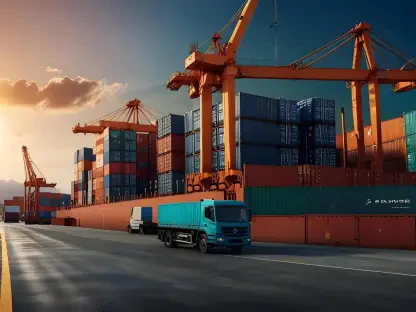Unveiling the E-Commerce Logistics Powerhouse
In the bustling landscape of Southeast Asia’s e-commerce, a staggering statistic grabs attention: Shopee, a leading platform under Sea Limited, has witnessed a jaw-dropping 300% surge in its stock value since early last year, reflecting not just a financial anomaly but a groundbreaking shift in logistics through its arm, SPX Express. With a hyperlocal delivery model that taps into underutilized labor and community infrastructure, Shopee has redefined efficiency in a $120 billion market. This analysis aims to dissect the market trends fueling this ascent, explore the data behind the operational success, and project future trajectories for stakeholders. The importance lies in understanding how such innovations can reshape competitive dynamics, offering critical insights for investors and businesses navigating the rapidly evolving e-commerce sector.
Decoding Market Trends and Operational Strategies
Hyperlocal Logistics as a Game-Changer
The e-commerce logistics market in Southeast Asia has long grappled with fragmented geographies and high operational costs, but Shopee’s SPX Express has emerged as a transformative force. By embedding delivery and collection points in local spaces like public housing estates in Singapore and small shops in Indonesia, the company has slashed the reliance on expensive centralized warehouses. Data reveals a striking 21% cost reduction in markets like Brazil this year, alongside next-day delivery in key urban hubs. This hyperlocal approach not only addresses geographic challenges but also aligns with the growing consumer demand for speed and affordability, positioning Shopee as a frontrunner in a region where logistics can make or break market share.
Shifting focus to scalability, the model’s adaptability across diverse markets underscores its market potential. In just a short span, SPX Express has captured a 25% share of Southeast Asia’s logistics sector, a remarkable leap from negligible presence a few years ago. The ability to replicate this strategy in emerging markets outside the region signals a broader trend: hyperlocal logistics could become a standard for cost-sensitive, fragmented geographies globally. Investors are taking note, as this operational edge translates directly into competitive advantages against rivals like Lazada and TikTok Shop, driving sustained market confidence.
Leveraging Underutilized Labor for Cost Efficiency
A pivotal trend in Shopee’s strategy is the innovative use of human capital, tapping into segments such as retirees, homemakers, and students to build a flexible workforce. Retirees, with their deep-rooted knowledge of local areas, ensure efficient last-mile delivery, while homemakers manage community collection points, handling significant daily parcel volumes. This labor model has led to a reported 6% drop in per-order logistics costs across Asia this year, highlighting a cost-effective alternative to traditional fixed labor systems. Such a structure not only reduces overhead but also fosters community trust through familiar faces, enhancing customer satisfaction.
However, this approach is not without its complexities. Low compensation rates, sometimes as minimal as S$0.30 per parcel, raise concerns about long-term worker retention and satisfaction. While the financial benefits are evident, the market must monitor how Shopee balances cost savings with ethical labor practices. This trend of leveraging gig economy principles in logistics reflects a broader shift toward flexible employment, but it also prompts scrutiny over sustainability, a factor that could influence investor sentiment if not addressed strategically.
Technology as a Catalyst for Market Dominance
Technology stands as a critical driver in amplifying Shopee’s logistics efficiency, a trend reshaping the broader e-commerce sector. SPX Express employs AI-driven route optimization and real-time inventory tracking, processing an impressive 400,000 parcels daily. During high-demand periods like Black Friday last year, the system achieved a 90% on-time delivery rate despite a 40% volume spike, showcasing the power of blending human effort with machine precision. Additional innovations, such as automated air waybills speeding up processing by 20%, further cement Shopee’s operational superiority in a tech-savvy market.
Looking deeper, the integration of features like deferred payment options has boosted purchase completion rates by 40%, illustrating how technology extends beyond logistics into consumer behavior. Yet, reliance on such systems introduces risks, including potential data breaches or technical failures, which could disrupt operations. As the market evolves, Shopee’s ability to mitigate these vulnerabilities while continuing to innovate will be crucial. This trend of tech-human synergy is likely to intensify, setting a benchmark for competitors and influencing investment in logistics tech across the $1.5 trillion global third-party logistics (3PL) market.
Financial Performance and Future Projections
Stock Surge Backed by Robust Financials
Shopee’s financial metrics paint a compelling picture of market strength, directly correlating with the 300% stock surge. Logistics revenue reached $799 million in the first quarter of this year, accompanied by a 14% growth rate, while adjusted EBITDA soared to $264.4 million, a stark reversal from prior losses. These figures underscore the profitability of the hyperlocal model, reflecting how operational efficiencies translate into bottom-line gains. For investors, this data signals not just a temporary spike but a sustainable growth trajectory, fueled by strategic innovations in a high-demand sector.
Projecting forward, the global 3PL market, expected to grow at a 10.1% CAGR from now to 2034, offers fertile ground for Shopee’s expansion. The company’s early success in markets like Brazil hints at untapped potential, with logistics services increasingly catering to third-party sellers. Market analysts anticipate that continued investment in technology and community engagement could further solidify Shopee’s position, potentially expanding its market share beyond Southeast Asia. This growth outlook makes the company a focal point for portfolios targeting e-commerce and logistics intersections.
Regulatory and Social Challenges on the Horizon
Despite the bullish outlook, certain market risks loom large, particularly around regulatory and social dimensions. The use of public spaces for parcel sorting has drawn scrutiny in several regions, prompting Shopee to adapt by shifting some operations to private areas. This flexibility mitigates immediate disruptions, but ongoing tensions could shape future logistics policies, a trend that businesses must monitor closely. Additionally, the low pay structure for delivery personnel poses a social risk, potentially impacting brand reputation if worker dissatisfaction escalates.
Looking ahead, regulatory shifts concerning gig worker rights may impose new compliance costs, a factor that could temper profit margins if not navigated adeptly. Shopee’s proactive stance in engaging communities offers a buffer, but the market will watch how these challenges evolve. For stakeholders, the projection is clear: balancing innovation with ethical considerations will be pivotal in sustaining growth, especially as competitors adopt similar hyperlocal strategies to close the gap.
Reflecting on Strategic Pathways Forward
Looking back, Shopee’s journey through hyperlocal logistics marked a transformative chapter in Southeast Asia’s e-commerce narrative, with SPX Express driving a 300% stock surge through unparalleled efficiency and market penetration. The financial turnaround and operational milestones achieved underscored a model that blended human capital with technological prowess. Challenges around regulation and labor practices emerged as critical hurdles, yet the company’s adaptive responses showcased resilience. For businesses and investors, the takeaway was to prioritize scalable, community-centric strategies while investing in technology to stay ahead. Moving forward, stakeholders should consider forging local partnerships to enhance trust, advocate for fair labor policies to preempt social backlash, and explore emerging markets for replication of this model. As the e-commerce landscape continues to evolve, the focus must shift toward sustainable innovation, ensuring that growth aligns with societal and regulatory expectations for long-term success.









